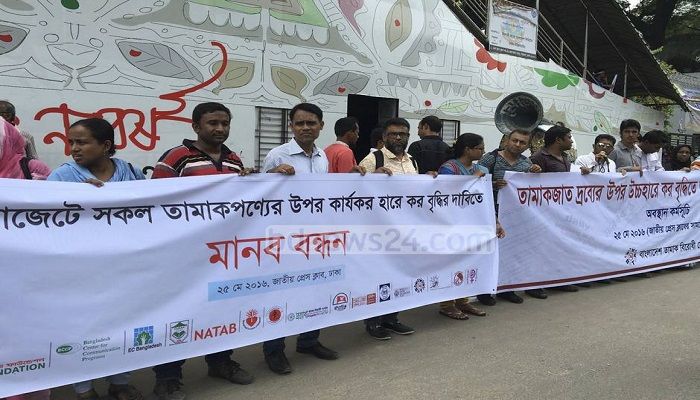
Mohammad Hasnain
Publish: 31 Aug 2019, 03:35 pm

Anti-tobacco Protest-25/05/16
The tobacco tax structure in Bangladesh is very complex. Bangladesh uses a tiered tobacco tax structure that imposes different ad valorem tax rates known as supplementary duty (SD) based on retail price slabs. Besides, there is a Value Added Tax (VAT) of 15 percent on the retail price. Because the ranges of price bands are not continuous, there are significant price gaps between brands in different price categories. This gap does not only allow smokers to switch to cheaper brands in response to price and tax increases, but it also creates incentives for tax avoidance and evasion among manufacturers. Government tax policy toward tobacco can be expected to serve at least three objectives: revenue, efficiency, and deterrence.
REVENUE
The ideal behaviour from the standpoint of revenue-motivated taxation is one which is popular but not sacred. As long as recreational elements are regarded as affordable by the general population, a relatively high tax burden is born with level-headedness because the general social feeling is that these substances are not necessities of life. Such taxes on recreational elements can be socially justified whether or not the use of those elements imposes a social cost over their untaxed price.
EFFICIENCY
A second distinct goal of tobacco taxation is to raise the price of tobacco to consumers to a level that fully reflects the social cost generated by their consumption. In these circumstances, an efficient price means that tobacco is purchased only by those for whom the net benefit is larger than the price, even when that price fully reflects the social cost of consumption. The poor are more sensitive to price increases, they are more likely to quit, cut back or never start using tobacco products. As a result, they save money and their health improves. Wealthier users tend not to change consumption patterns as much in response to price increases, which means they wind up paying the majority share of the taxes. If the balance between social cost and consumer price is the objective of the policy, the government does not wish to impose taxes unless external social costs exist, and the government would wish to cease taxing at the point where price reflects the social cost.
DETERRENCE
A third distinctive objective of tobacco tax policy might be to discourage smoking or use of tobacco. When the government decides to actively discourage a behaviour, taxation is a tool that exists to produce another reason not to purchase tobacco items with increasing level of taxation until black market institutions have effectively nullified the relationship between the official tobacco tax and the effective price for most smokers.
These three different purposes of taxation implicate different definitions of what would be an optimal level of tobacco tax. They may also lead to different conceptions of what constitutes justice in tobacco taxation, although this is far from clear. The optimal level of a tobacco tax designed to produce efficiency is that which reflects the social cost of the tobaccos being used. Any higher tax is suboptimal because it discourages smoking among persons for whom benefits of tobaccos outweigh the costs, as shown by their willingness to pay a price that reflects the true social cost. Any lower tax would encourage smoking when the benefits to the smoker do not outweigh the total community cost.
Policymakers must drive to advocate tobacco taxation for two reasons. First, to route the funding into health and development programs; for example, the income from such taxes can be used to fund universal health coverage or education initiatives. Second, taxation can help address the unpremeditated side effects of the use of tobacco products such as second- and third-hand smoking.
For example, according to WHO, tobacco use not only kills more than 7 million people worldwide every year but almost 900,000 deaths of non-smokers exposed to second-hand smoke. In Bangladesh, 35 percent of adults are currently using tobacco either in smoked and/or in a smokeless form. Furthermore, 43 percent and 39 percent of adults are exposed to second-hand smoke at their workplaces and in their homes, respectively. And in case of third-hand smoke, children of smokers are especially at risk of exposure and contamination because tobacco residue is noticeably present in dust throughout places where smoking has occurred.
Subscribe Shampratik Deshkal Youtube Channel
© 2024 Shampratik Deshkal All Rights Reserved. Design & Developed By Root Soft Bangladesh